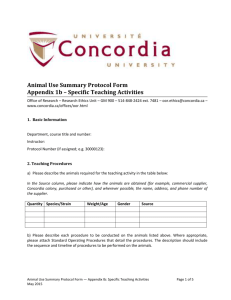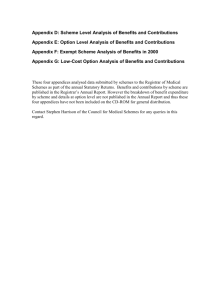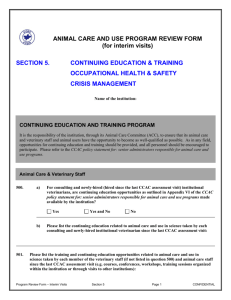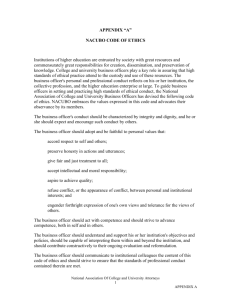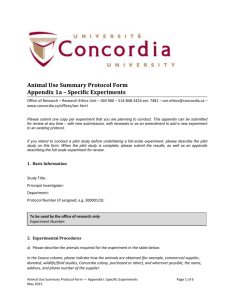Office of Research - Concordia University
advertisement
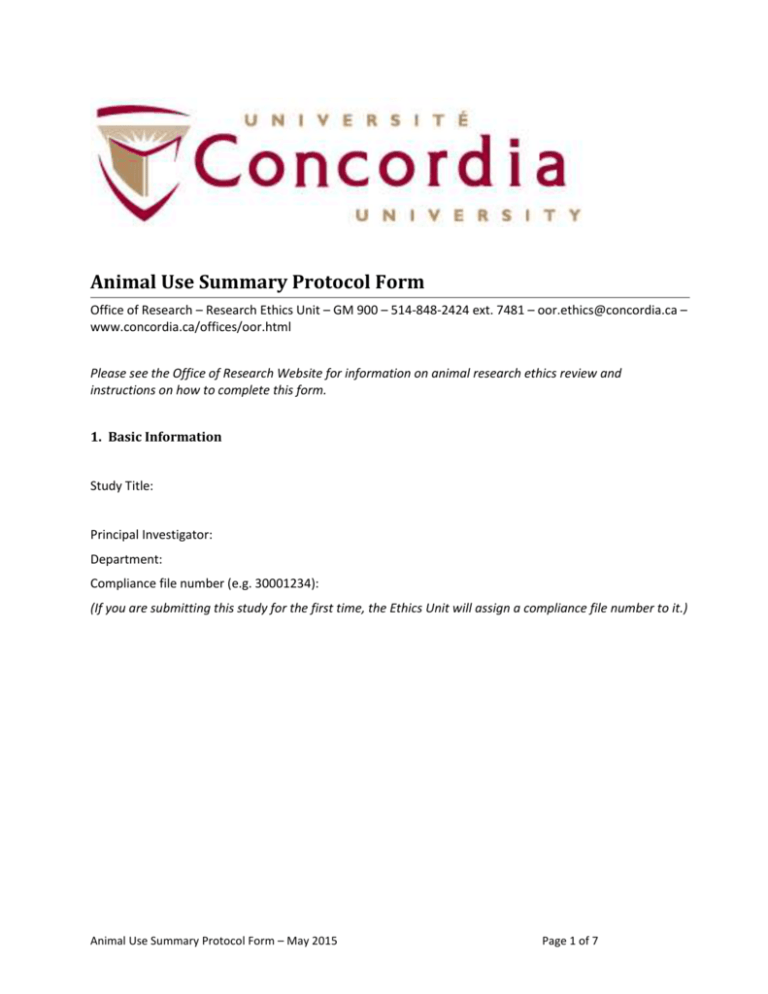
Animal Use Summary Protocol Form Office of Research – Research Ethics Unit – GM 900 – 514-848-2424 ext. 7481 – oor.ethics@concordia.ca – www.concordia.ca/offices/oor.html Please see the Office of Research Website for information on animal research ethics review and instructions on how to complete this form. 1. Basic Information Study Title: Principal Investigator: Department: Compliance file number (e.g. 30001234): (If you are submitting this study for the first time, the Ethics Unit will assign a compliance file number to it.) Animal Use Summary Protocol Form – May 2015 Page 1 of 7 2. Research Team and Contact Information Please list all members of the research team in the table below. In case of an emergency involving animals used for the research or teaching activities, team members will be contacted one by one until someone is reached, in the order in which they appear in the table below. Please add additional rows to this table as needed. Name Role* Daytime Phone Evening Phone e-mail Internal Address (Building and room number) Animal Care Training Introduction to Animal Care date: _____________ Title of session: date: _____________ Other training: Introduction to Animal Care date: _____________ Title of session: date: _____________ Other training: Introduction to Animal Care date: _____________ Title of session: date: _____________ Other training: *For example, Principal Investigator, Post-doctoral Fellow, Graduate Student, Laboratory Technician Animal Use Summary Protocol Form – May 2015 Page 2 of 7 3. Funding Sources Please list all sources of funds that will be used for your research involving animals in the coming year. Funding Source Project Title* Grant Number† Award Period Start End Notes: *Please provide the project title as it appears on the Notice of Award or equivalent documentation. † If you have applied for funding, and the decision is still pending, please enter “applied”. If you intend to apply for funding, but haven’t yet done so, please enter “intend to apply”. Please note that unfunded research must be peer-reviewed as per the Procedures For The Ethical Use Of Animals In Research And Teaching before approval. 4. Canadian Council on Animal Care Categorizations a) Which of the following best describes the purpose of animal use under this protocol? Please choose only one. Please refer to the Canadian Council on Animal Care (CCAC) website (http://www.ccac.ca/Documents/Assessment/Reporting-AUDF.pdf) for examples of each purpose of animal use. Studies of a fundamental nature in sciences relating to essential structure or function (i.e. biology, psychology, biochemistry, pharmacology, physiology, etc.) Studies for medical purposes, including veterinary medicine, that relate to human or animal disease or disorders. Studies for regulatory testing of products, for the protection of humans, animals, or the environment. Studies for the development of products or appliances for human or veterinary medicine, animal nutrition, animal reproduction and/or animal care. Education and Training of individuals in post-secondary institutions or facilities. Please provide the course number: b) Do you intend to produce antibodies as part of this research? ☐ Yes Animal Use Summary Protocol Form – May 2015 Page 3 of 7 ☐ No If you answered “Yes”, please contact the Manager, Research Ethics for more instructions on the information to be submitted. Please note that antibody production is subject to guidelines from the Canadian Council on Animal Care. 5. Lay Summary Please provide a brief description of the research or teaching activity in everyday language. The summary should make sense to an individual with no discipline-specific training, and it should not use overly technical terms. Please do not submit your grant application. a) Background, Objectives and Methods Please provide a broad description of the methods to be used. Specific experiments or teaching activities are to be described in Appendix I. b) Animal Model Please describe the characteristics of the animal that make the species or strain appropriate for the research or teaching objectives, for example, structural, behavioral, physiological, biochemical or other features and considerations. Cost may not be used as a justification. c) Anticipated Impact Please describe how the research or teaching activity is expected to benefit humans or animals, either in terms of immediate applications of the findings or contributions to scientific knowledge. 6. Alternatives a) Please explain the need to use animals in this research or teaching activity, and why alternatives such as in vitro or ex vivo systems would be inappropriate to meet your research or pedagogical objectives. The CCAC requires more than a simple statement that a replacement alternative is not available. Animal Use Summary Protocol Form – May 2015 Page 4 of 7 b) Please describe any alternatives to animal use, such as in vitro or ex vivo systems, that are already incorporated into the research or course design. 7. Hazards a) EHS Certificate Number: b) Will this study use hazardous chemicals (e.g. isoflurane, acids, corrosives, alcohol)? Please specify whether any chemicals are classified as carcinogenic, mutagenic, toxic for reproduction or harmful to unborn children. For studies involving anesthetic gases, please describe ventilation procedures to protect against human exposure. ☐ ☐ No Yes (specify): c) Will this study use biohazardous material (e.g. microorganisms, microbial toxins, cell lines, recombinant DNA, viral vectors)? ☐ ☐ No Yes (specify): d) Will this study use radioactive material? ☐ ☐ No Yes (specify): e) Will this study use controlled substances? ☐ ☐ No Yes (specify): e) Will this study use any other types of hazard (e.g. lasers, hazardous machines such as cutting equipment or drills, electrical hazards, hazardous processes, noise, UV light)? ☐ ☐ No Yes (specify): Animal Use Summary Protocol Form – May 2015 Page 5 of 7 8. Wildlife certification ☐ Not applicable a) Please describe any wildlife permits required to carry out the protocol. If you have received them, please submit a copy. If you have not yet received them, please state when you expect to receive them and submit a copy when you do. b) Please describe the type or degree of potential ecological disruption expected, for example, the consequences to reproduction, or survival of animals studied c) Please describe procedures for disposal of animal carcasses, if applicable. 9. Appendices If the protocol involves any of the following, please complete the corresponding appendix. Please complete a copy of Appendix 1a for each specific experiment to be conducted under this protocol. Specific experiments must be submitted for review at the time of initial review, or as they are developed over the course of the study. For teaching activities, please submit Appendix 1b. Appendix 1a: Specific Experiments Appendix 1b: Teaching Activities Appendix 2: Genetically Modified Animals All appendices are available on the office of research website (http://www.concordia.ca/research/forresearchers/ethics.html#tab1) 10. Disposition a) What will be done with animals when they are no longer needed for this research? Please note that only animals designated for experimental or breeding purposes should be kept. Long-term “storage” without reason is discouraged. ☐ Euthanized – method: Animal Use Summary Protocol Form – May 2015 Page 6 of 7 ☐ ☐ Anesthetic / physical method (please specify): ☐ CO2 / physical method (please specify)*: ☐ Other (if a physical method is used without anesthesia, please provide justification): Other – please specify (e.g. returned to natural habitat; donated, recycled, reused): *As with euthanasia carried out in response to an animal reaching a humane endpoint, if CO2 euthanasia will be used, please provide a justification, and methodology based on CCAC guidance. 11. Signature and Declaration I declare that this Animal Use Summary Protocol Form and its appendices accurately describe the proposed animal use. I will only use animals in accordance with an Animal Use Summary Protocol Form and its appendices approved by the University Animal Research Ethics Committee (UAREC). I will not deviate from this protocol unless the modification has been approved by the UAREC. I will ensure that only the personnel listed in section 2 conduct procedures involving animals under this Animal Use Summary Protocol Form. I will ensure the personnel have all required training and that they are competent in executing the approved procedures. If any unexpected problems or complications involving animal health and well-being occur during this study, I will complete an Animal Incident Report and deliver it to the Manager of the Animal Care Facility within 24 hours of the incident. I acknowledge that approval will expire on the date specified on the Certificate of Ethical Acceptability for Research or Teaching Involving the Use of Animals. I will not use animals after that date unless I have duly applied for renewal of my approval. I will ensure that all animals used in this protocol will be cared for in accordance with: The CCAC Guide to the Care and Use of Experimental Animals and any other applicable CCAC policy; The Concordia University Policy on the Ethical Use of Animals in Research and Teaching (VPRGS-13) and its associated procedures. This form may be submitted by e-mail in MS Word or PDF format to oor.ethics@concordia.ca. E-mail submissions sent from the researcher’s official Concordia address will be deemed equivalent to an ink-onpaper signature. Signature of Principal Investigator: ________________________________________ Date: ____________________________ Animal Use Summary Protocol Form – May 2015 Page 7 of 7
